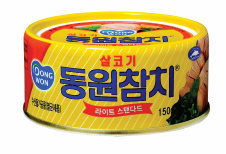Fishing for a good idea, netting a hit with tuna

Dongwon
When Kim Jae-chul, the chairman of Dongwon Industries, was taking a business administration course at Harvard in 1981, the lecturer told the class that people start eating canned tuna when the gross national income exceeds $2,000. He couldn’t resist the opportunity he believed was in front of him.
At the time, some 6,000 tons of fresh tuna were being caught by Korean companies and exported, but he thought the tuna would be better used if canned. Although Korea’s GNI was only at $1,000, he started his business with the belief that demand for the product would increase because canned mackerel was already part of the Korean diet.
Dongwon opted to make its tuna with soft meat dipped in oil, veering away from the canned tuna recipe used in other countries at the time. The tuna were frozen the minute they were reeled onto the fishing boats and then seared before being sealed into the can.
The problem was the oil. Dongwon tried using sesame oil, which is widely used in Korea, but the sesame oil burned during the sterilization process, changing the color and taste of the tuna. Next they tried sunflower seed oil, but it cost too much.
“We tested around 10 different oils over several months,” said Song Myung-joon, vice president of Dongwon F&B, the food division of Dongwon. “We finally decided on cottonseed oil,” Song added.
Cottonseed oil didn’t have a distinctive flavor of its own, which helped bring out the natural taste of the tuna.
Last year, the company changed from cottonseed oil to canola to reflect current health trends.
The next problem was choosing the tuna. Yellow fin and albacore were too expensive. When canned, both kinds of tuna were oily and lacked flavor. Dongwon decided to go with skipjack, whose meat was softer than others.
When Dongwon canned tuna hit the market in December 1982 it was labeled with the word “meat,” to enhance its image as a luxury product. Chairman Kim and his employees then went to work to promote the product, traveling to amusement parks, mountains and train stations to hold free tasting events on weekends and holidays.
The product has held the top spot in the market since it was introduced, with a market share exceeding 70 percent. Last year the company sold 210 million cans of tuna, or five cans for every Korean.
By Choi Ji-young [ojlee82@joongang.co.kr]










with the Korea JoongAng Daily
To write comments, please log in to one of the accounts.
Standards Board Policy (0/250자)